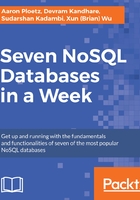
Neo4j
Some application use cases or data models may place as much (or more) importance on the relationships between entities as the entities themselves. When this is the case, a graph database may be the optimal choice for data storage. In this chapter, we will look at Neo4j, one of the most commonly used graph databases.
Over the course of this chapter, we will discuss several aspects of Neo4j:
- Useful features
- Appropriate use cases
- Anti-patterns and pitfalls
- Ways of using Neo4j with languages such as:
- Cypher
- Python
- Java
Once you have completed this chapter, you will begin to understand the significance of graph databases. You will have worked through installing and configuring Neo4j as you build up your own server. You will have employed simple scripts and code to interact with and utilize Neo4j, allowing you to further explore ideas around modeling interconnected data.
We'll start with a quick introduction to Neo4j. From there, we will move on to the appropriate graph database use cases, and begin to learn more about the types of problems that can be solved with Neo4j.